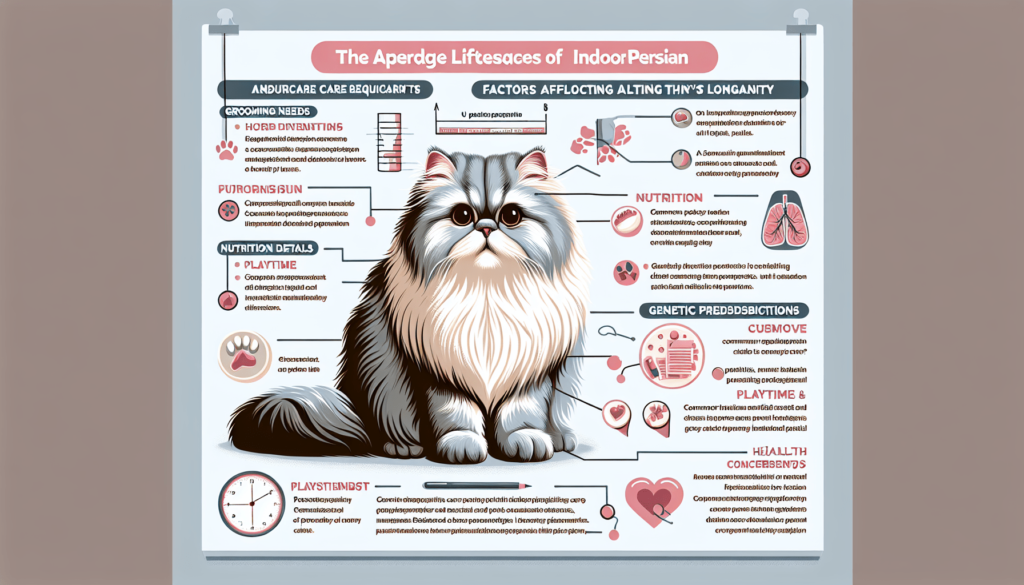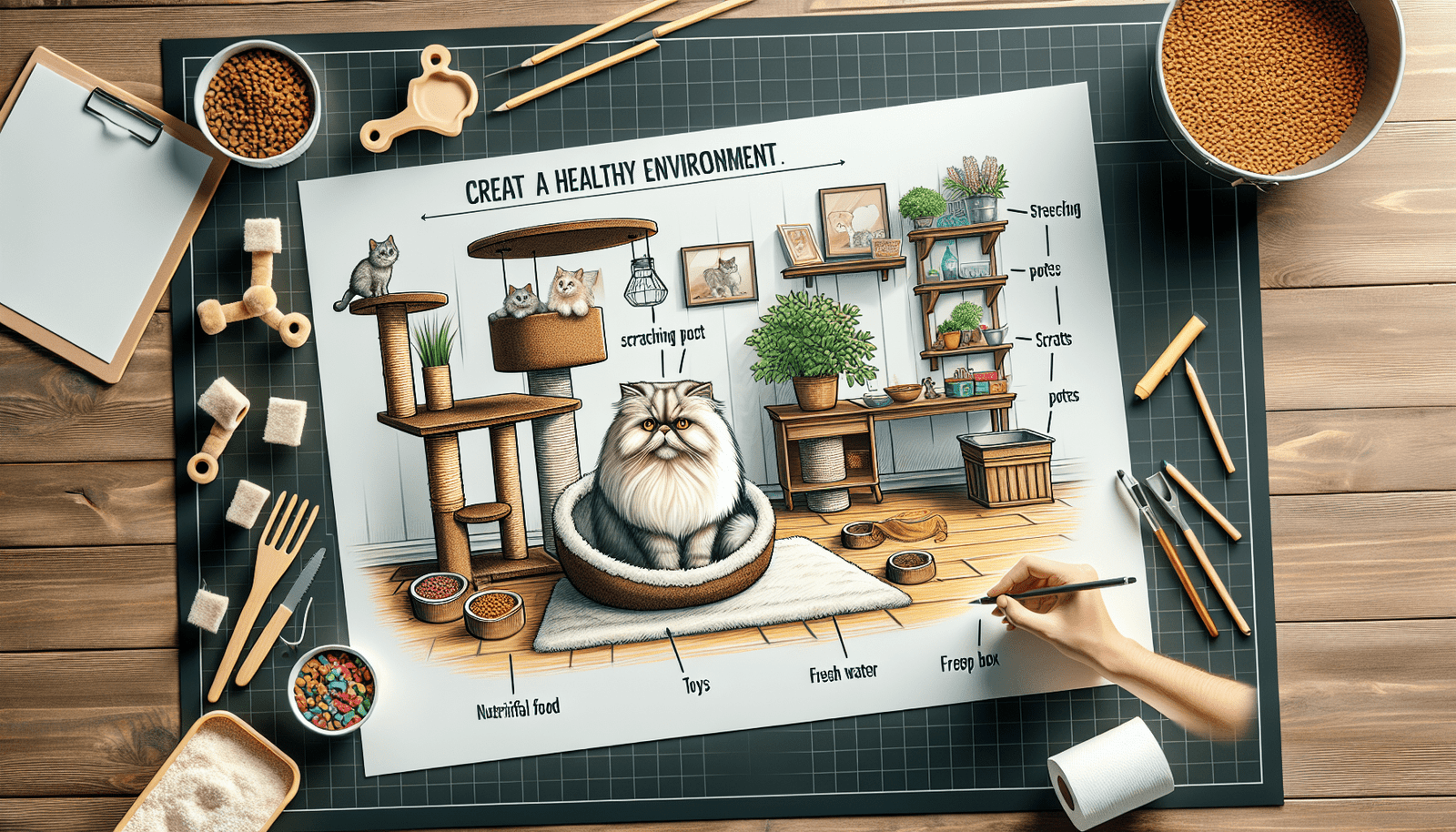Imagine having a furry companion that brings joy and comfort to your life for many years to come. In this article, we explore the fascinating topic of the lifespan of indoor Persian cats. Discover the secrets behind these majestic creatures and uncover how long they can grace your home with their presence. So, get ready to embark on a journey of feline longevity and learn all there is to know about the fascinating lifespan of indoor Persian cats.
Average Lifespan of Indoor Persian Cats
Persian cats are renowned for their luxurious coats, expressive eyes, and calm demeanors. These elegant felines often find themselves as beloved indoor pets, where they can thrive in safe and comfortable environments. As a Persian cat owner, it’s essential to understand the factors that can affect the lifespan of your furry companion. By considering genetics, healthcare, nutrition, living conditions, and exercise, you can ensure that your Persian cat enjoys a long and healthy life.
Factors Affecting Lifespan
Genetics
Genetics play a significant role in determining the lifespan of indoor Persian cats. Just like any other animal, Persian cats inherit certain traits and predispositions from their parents. Unfortunately, some Persians are more susceptible to certain health issues due to genetic factors. It’s vital to research and choose a reputable breeder who prioritizes the overall health and well-being of their cats. Opting for a breeder who carefully selects cats with good genetic backgrounds can increase the chances of your Persian enjoying a longer lifespan.
Healthcare
Proper healthcare is crucial in maximizing your Persian cat’s lifespan. Regular vet check-ups should be a priority to monitor and address any potential health concerns. Vaccinations play a vital role in preventing common diseases, and your vet will provide a vaccination schedule suitable for your cat’s age and lifestyle. Dental care is also essential, as Persian cats are prone to dental issues. Regular brushing and annual professional cleanings can prevent dental diseases that can negatively impact your cat’s overall health. Additionally, keeping up with parasite control measures, such as flea and tick prevention, is crucial to ensure a healthy and comfortable life for your Persian companion.
Nutrition
Nourishing your Persian cat with a high-quality diet is paramount to their long-term health and longevity. Choose cat food that is specifically formulated for Persian cats, as their dietary needs can differ from other breeds. Look for food that contains essential nutrients, such as protein, vitamins, and minerals, to support their overall well-being. Providing fresh water at all times will ensure proper hydration, and you may also consider adding wet food to their diet for added moisture.
Living Conditions
Creating a clean and safe environment is vital for the well-being and longevity of your Persian cat. Regular cleaning of their litter box, bedding, and living area will help prevent the spread of bacteria and parasites. Providing a stress-free surroundings is also critical, as stress can lead to various health issues. Make sure your cat has a quiet and peaceful space where they can retreat and feel secure. Minimizing exposure to loud noises, excessive commotion, and other potential stressors can contribute to a longer and happier life for your Persian companion.
Exercise and Mental Stimulation
While Persian cats are known for their calm and less active nature compared to some other breeds, regular exercise and mental stimulation are still essential. Engaging your Persian cat in play sessions with appropriate toys can help keep them physically active and mentally stimulated. It’s important to find the right balance, as overexertion can lead to stress or injury. Providing scratching posts, climbing trees, and other forms of environmental enrichment can also keep your Persian entertained and mentally engaged.

Genetics
Inherent Health Issues
Although Persian cats are charming and beautiful, they are also prone to certain inherent health issues. These may include respiratory problems, eye and ear issues, skin and coat conditions, urinary tract problems, renal disease, dental issues, obesity, hairballs, degenerative joint disease, and an increased risk of cancer. While these conditions may sound daunting, being aware of them allows you to take proactive steps in preventing and managing them.
Breeding Practices
Choosing a responsible breeder is crucial when it comes to the genetics and health of your Persian cat. Reputable breeders prioritize the overall health of their cats and work to minimize the risk of genetic issues. They carefully select breeding pairs, ensuring they are free from known hereditary diseases and deformities. By choosing a Persian cat from a reputable breeder, you give your feline companion a better chance of enjoying a longer and healthier life.
Healthcare
Vet Check-ups
Regular vet check-ups are essential for monitoring your Persian cat’s health and detecting any potential issues early on. Your vet will conduct a thorough examination, assess their overall condition, and address any concerns you may have. These routine check-ups also provide an opportunity to stay up to date on vaccinations, discuss preventive care measures, and receive professional advice on maintaining your cat’s well-being.
Vaccinations
Vaccinations are a vital part of your Persian cat’s healthcare regimen. They protect your feline friend from common and potentially life-threatening diseases. Your vet will establish an appropriate vaccination schedule based on your cat’s age, lifestyle, and risk factors. Core vaccinations typically include those against feline panleukopenia, herpesvirus, calicivirus, and rabies. By ensuring your Persian is up to date with their vaccinations, you significantly reduce the likelihood of them contracting preventable diseases.
Dental Care
Dental issues are prevalent among Persian cats due to their characteristic facial structure and crowding of teeth. Regular dental care is essential to prevent gum disease, tooth decay, and other oral health problems. Brushing your cat’s teeth regularly helps remove plaque and tartar buildup. Additionally, providing dental treats or incorporating dental-specific food into their diet can contribute to oral health maintenance. Professional dental cleanings performed by your vet may also be necessary to address stubborn tartar and maintain optimal dental hygiene.
Parasite Control
Parasites can pose significant risks to your Persian cat’s health. Fleas, ticks, ear mites, and intestinal worms are some of the common parasites your cat may encounter. Implementing a regular parasite control regimen, including topical or oral medications, can help protect your cat from these pesky invaders. Your vet will guide you on the appropriate products and frequency of administration based on your cat’s specific needs and the prevalence of parasites in your area.
Emergencies and Medical Conditions
Despite your best efforts, emergencies and unforeseen medical conditions can still arise. It’s crucial to be prepared and to seek immediate veterinary care if your Persian cat exhibits any concerning symptoms or behaviors. Timely diagnosis and treatment can make a significant difference in the outcome of various medical conditions. Familiarize yourself with the nearest emergency veterinary clinic and keep their contact information readily available for any urgent situations.

Nutrition
Quality Food
Feeding your Persian cat a high-quality diet is essential for their overall health and well-being. Look for cat food that features a balanced blend of protein, healthy fats, vitamins, and minerals. Avoid food that contains excessive fillers, artificial additives, or low-quality ingredients. Opt for reputable brands that prioritize the nutritional needs of Persian cats. Giving your cat a well-rounded diet sets the foundation for a healthy life and can help prevent the onset of certain health issues.
Appropriate Diet
Persian cats may have specific dietary requirements due to their distinct facial structure and potential susceptibility to urinary tract issues. Consult with your vet to determine the appropriate diet for your Persian, considering factors such as age, weight, health conditions, and activity level. They may recommend a diet formulated to support urinary tract health or diets tailored to specific age groups, such as kitten, adult, or senior formulas. Providing a thoughtfully balanced and appropriate diet will promote optimal nutrition and contribute to a longer and healthier life for your Persian companion.
Hydration
Proper hydration is essential for keeping your Persian cat healthy and preventing certain health issues. Cats have a relatively low thirst drive, so it’s crucial to encourage them to drink an adequate amount of water. Provide fresh water in clean bowls throughout the house, ensuring it is easily accessible for your cat. Some Persian cats prefer running water, so a pet fountain might be a helpful addition. Additionally, you can supplement your cat’s fluid intake by incorporating wet food into their diet, as it contains a higher water content compared to dry kibble.
Living Conditions
Clean and Safe Environment
Creating a clean and safe living environment is vital for the health and well-being of your Persian cat. Regularly cleaning their litter box and providing fresh litter helps prevent the spread of bacteria and minimizes the risk of litter box-related issues. Regular vacuuming and dusting also contribute to a clean environment, reducing the chances of respiratory problems and allergies. Additionally, ensuring that your home is free from toxic substances, such as certain plants, cleaning chemicals, and human medications, is crucial to preventing accidental poisoning.
Stress-Free Surroundings
Persian cats thrive in calm and stress-free surroundings. They are sensitive to loud noises, sudden changes, and excessive commotion. Minimize stress by providing a designated quiet space where your cat can retreat and feel secure. This can be a cozy bed, a blanket in a secluded corner, or a dedicated room where they can have some alone time. If you anticipate any upcoming events that may cause stress, such as moving to a new home or introducing a new pet, take steps to gradually acclimate your Persian to the changes and provide them with reassurance and comfort.
Exercise and Mental Stimulation
Physical Activity
While Persian cats are generally less active compared to some other cat breeds, regular exercise is still essential to maintain their overall health and well-being. Engage your Persian in play sessions using interactive toys, such as feather wands or laser pointers. Encouraging them to climb up and down scratching posts, providing opportunities for gentle wrestling, and incorporating small bursts of physical activity throughout the day can help keep them active and prevent weight gain. Be mindful of your cat’s individual preferences and energy levels when determining the appropriate exercise routine.
Enrichment Toys and Activities
Mental stimulation is just as crucial as physical exercise for the well-being of your Persian cat. Provide enrichment toys that encourage problem-solving and engage their instinctual behaviors, such as puzzle feeders or treat-dispensing toys. You can also create stimulating environments by setting up cat trees, hiding treats throughout the house, or introducing new toys periodically. These activities keep your cat mentally engaged, ward off boredom, and promote a happier and more fulfilling life.
Lifestyle Considerations
Indoor vs Outdoor
When considering the lifespan of your Persian cat, the decision between indoor and outdoor living is a critical factor. While allowing your cat outdoor access exposes them to fresh air and natural stimuli, it also brings potential dangers, such as traffic accidents, predators, exposure to diseases, and the risk of getting lost. Indoor living provides a controlled and safe environment, minimizing these risks and prolonging your Persian’s lifespan. However, if you choose to give your Persian supervised outdoor access, ensure it is done in a secure and controlled manner, such as by using enclosures or installing cat-proof fences.
Single vs Multiple Cat Household
The social dynamics within your Persian cat’s living arrangement can influence their overall well-being and lifespan. While some Persian cats thrive in single-cat households, others may benefit from the companionship of fellow felines. If you choose to introduce another cat into your household, proper introductions and gradual acclimation are crucial to minimize stress and potential conflicts. Additionally, providing separate resources, such as litter boxes, feeding areas, and resting spaces, ensures that each cat’s needs are met and reduces competition-related stress.
Common Health Issues and Care
Persian cats are predisposed to certain health issues, and being aware of these conditions can help you provide the necessary care and early intervention to prolong their lifespan.
Respiratory Problems
Due to their characteristic facial structure, Persian cats are prone to respiratory issues. Regular observation of their breathing patterns and any signs of sneezing, coughing, or difficulty breathing is essential. If you notice any respiratory problems, promptly seek veterinary care to address underlying causes and prevent respiratory infections.
Eye and Ear Issues
Persian cats are known for their striking and expressive eyes, but they are also prone to eye problems such as excessive tearing, eye infections, clogged tear ducts, and corneal ulcers. Similarly, their adorable floppy ears can be susceptible to infections and excess wax buildup. Regular cleaning and monitoring of your Persian cat’s eyes and ears are crucial to maintain their health and prevent discomfort or vision/hearing loss.
Skin and Coat Conditions
Persians have long, dense coats that require regular grooming to prevent matting and skin issues. Brushing them daily helps remove loose hair, prevents tangles, and stimulates healthy blood flow to the skin. Pay attention to any signs of skin irritation, dryness, or excessive scratching, as these may indicate an underlying skin condition that requires veterinary attention.
Urinary Tract Problems
Persian cats are prone to urinary tract issues, including bladder stones, urinary tract infections, or blockages. Proper hydration, appropriate diet, and monitoring your cat’s litter box habits are vital for early detection and intervention. If you notice any changes in your Persian’s litter box behavior, such as frequent urination, straining to urinate, or blood in the urine, consult your vet immediately.
Renal Disease
Chronic kidney disease is prevalent among Persian cats, and early detection and proper management are essential in extending their lifespan. Routine bloodwork and urine analysis can help identify kidney disease in its early stages, allowing for timely intervention with special diets, medications, and other treatment modalities.
Dental Issues
Persian cats are prone to dental problems, including gum disease, tooth decay, and tooth loss. Regular dental care, including brushing your cat’s teeth and professional cleanings, is essential in preventing these issues. Monitor your cat for signs of mouth pain, difficulty eating, or bad breath, as these may indicate dental problems requiring veterinary attention.
Obesity
Persian cats can be prone to obesity due to their reduced activity levels and proper nutrition is essential in maintaining a healthy weight. Monitoring portion sizes, avoiding excessive treats, and engaging in regular play sessions are vital in preventing obesity and its associated health consequences.
Hairballs
The long, luxurious fur of Persian cats can lead to increased hairball formation. Regular grooming and hairball control products can help minimize the discomfort and risks associated with hairballs. If your cat shows signs of excessive grooming, coughing, or gagging, consult your vet for appropriate hairball management strategies.
Degenerative Joint Disease
As Persian cats age, they may develop degenerative joint disease, also known as osteoarthritis. This condition can cause pain, stiffness, and reduced mobility. Providing appropriate bedding, ramps or stairs, and joint support supplements can help alleviate discomfort and maintain mobility.
Cancer
Persian cats may have an increased risk of developing certain types of cancer, such as squamous cell carcinomas and lymphoma. Regular vet check-ups, diligent monitoring for any abnormal lumps or growths, and early intervention maximize the chances of successful treatment.
Importance of Regular Check-ups and Early Detection
Preventive care and early detection are vital in ensuring the long and healthy life of your Persian cat.
Preventive Care
Regular vet check-ups and adherence to vaccination schedules play a crucial role in preventive care. By staying updated with routine exams, vaccinations, and parasite preventatives, you can reduce the risk of your Persian contracting preventable diseases or suffering from undetected health issues.
Spotting Early Signs
Being familiar with your Persian cat’s normal behavior, habits, and physical appearance allows you to spot any early signs of illness or discomfort. Pay attention to changes in appetite, litter box habits, grooming patterns, body weight, or any unusual behaviors. If you notice anything out of the ordinary, consult your vet promptly for evaluation and appropriate intervention.
Timely Diagnosis and Treatment
Early detection of health issues can significantly impact the outcome and prognosis. Regular vet check-ups, including bloodwork, diagnostic imaging, and other screening tests, can help identify potential problems before they become severe or irreversible. Timely diagnosis and treatment increase the chances of successful intervention and a longer and healthier life for your Persian cat.
In conclusion, the average lifespan of indoor Persian cats can be extended through various factors. Genetics, healthcare, nutrition, living conditions, and exercise all play vital roles in promoting longevity and overall well-being. By providing a clean and safe environment, high-quality diet, regular veterinary care, and mental stimulation, you can ensure that your Persian cat enjoys a happy and healthy life by your side for many years to come.

